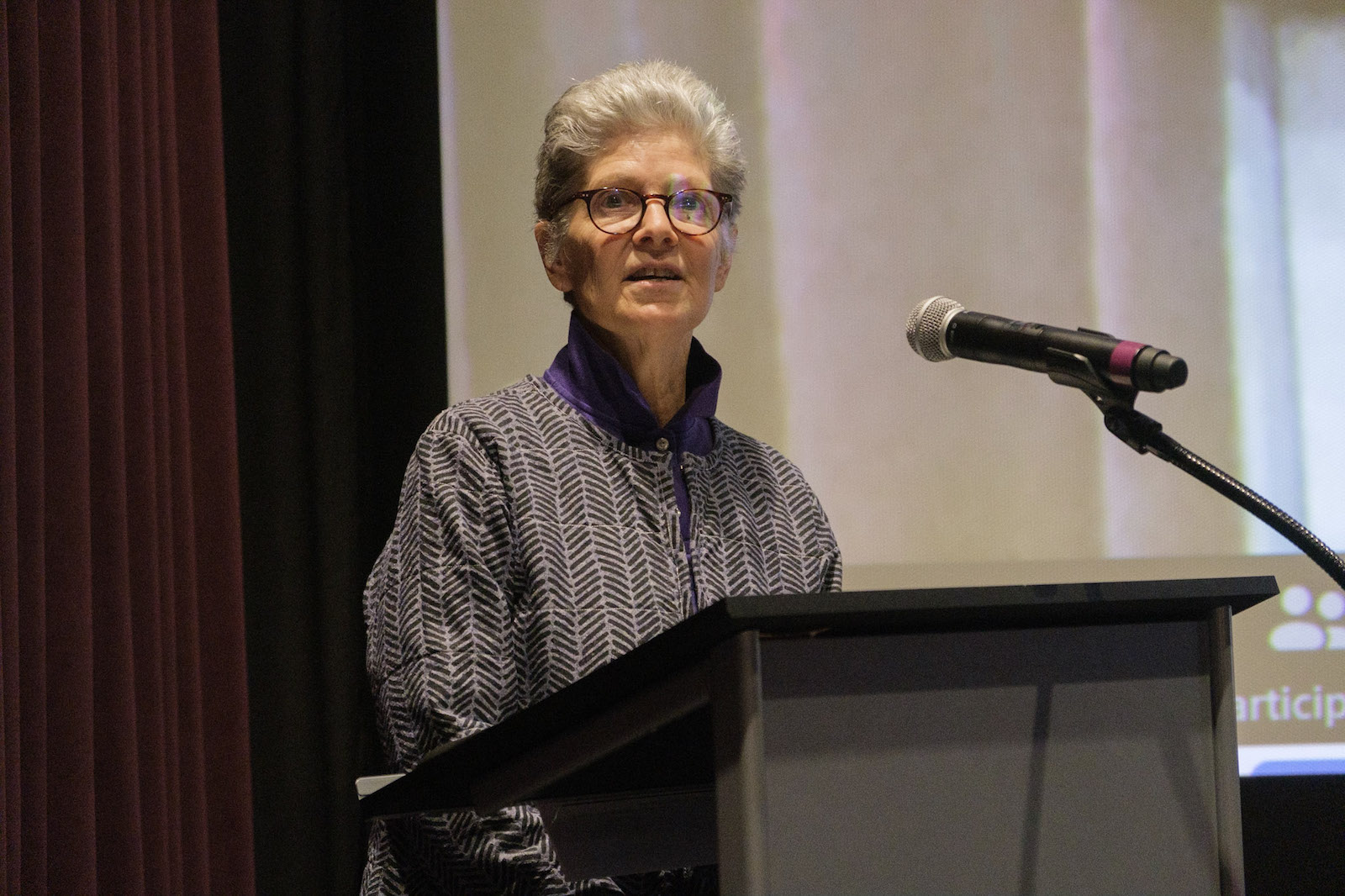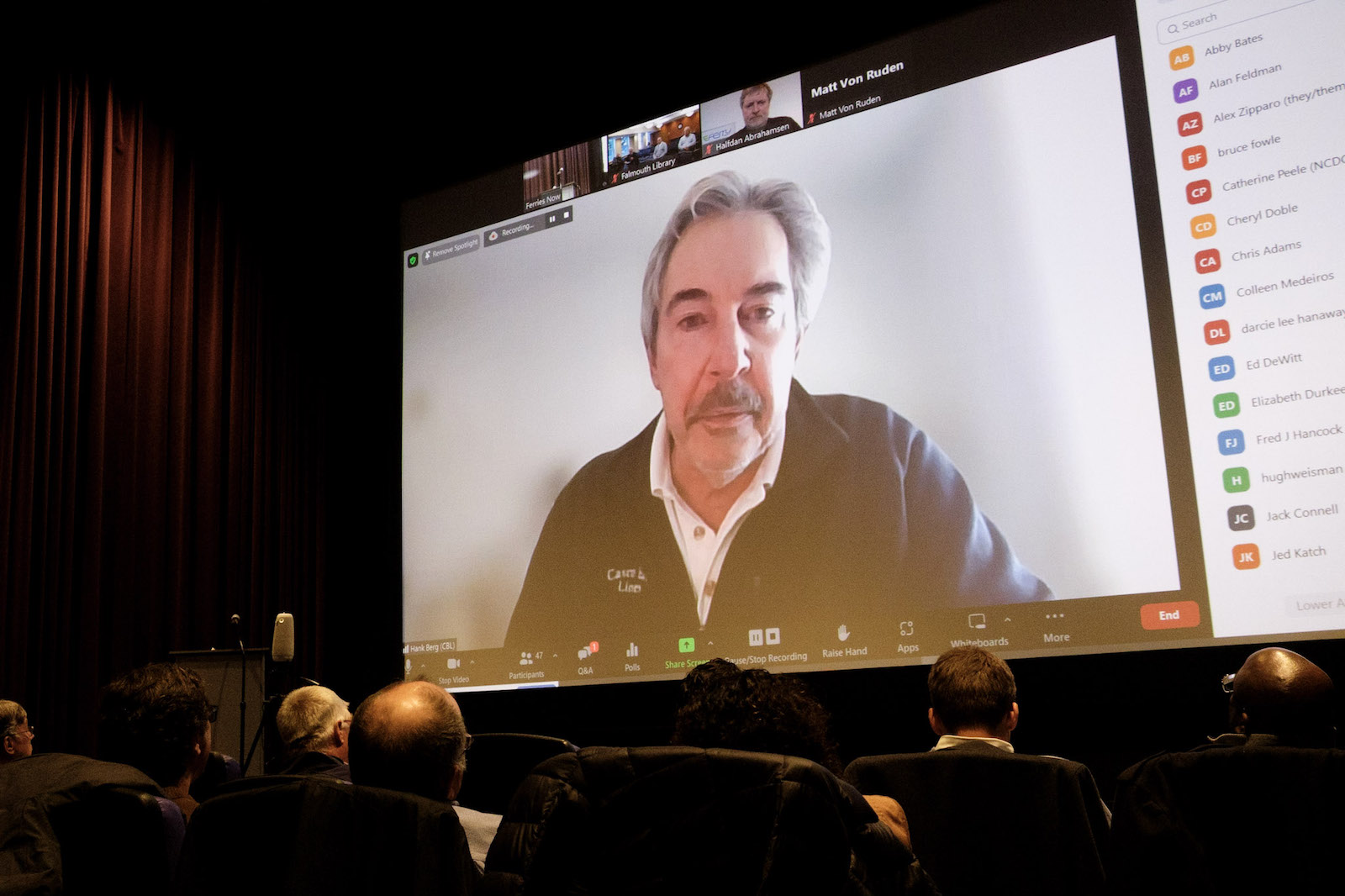Electric ferry operators from Denmark, Maine and Washington state shared their experiences Friday in a half-day public conference aimed at encouraging the Steamship Authority to begin reducing its vessels’ dependency on fossil fuel.
Held at the Martha’s Vineyard Film Center and online, the discussion was organized and hosted by Martha’s Vineyard Commission energy planner Kate Warner, a longtime Island advocate for sustainability who joined the commission staff last year.
“It’s time for a paradigm shift,” Ms. Warner said in her opening remarks on the film center stage, as she noted the state administration’s goal of ending carbon dioxide emissions throughout the Massachusetts economy by 2050.
“The Steamship Authority will need to decarbonize,” Ms. Warner said.
The sold-out event was sponsored by the Martha’s Vineyard Vision Fellowship, Vineyard Power and Vineyard Wind, and also featured representatives from Eversource and the Steamship Authority, including SSA general manager Robert Davis.
“I want to assure you that we’re not lagging behind the rest of the industry,” Mr. Davis told the audience. “We’re keeping abreast of what’s going on.”
Halfdan Abrahamsen, project manager with the renewable energy office of the municipality of Ærø in Denmark, opened the conversation by discussing his work with electric ferries, both the benefits and the costs associated with it. Ærø is an island in the Baltic Sea that has been utilizing an all-electric ferry to carry passengers and vehicles since 2019.
“We hardly waste any energy,” Mr. Abrahamsen said, referring to the island’s 195-foot-long electric ferry. “A regular diesel system would waste 70 per cent of the energy supply.”
The ferry is powered by 840 marine batteries that are cooled with water and non-toxic thermal foam, the latter of which also smothers fire. With no moving parts, engine maintenance is minimal, Mr. Abrahamsen said, while the batteries get their charge from a six-turbine, cooperatively-owned wind farm on Ærø.
Community ownership was essential to the island’s embrace of wind power, Mr. Abrahamsen said.
“Wind turbines are not too pretty, but they’re beautiful if you own them,” he said.
Charging infrastructure posed more of a funding challenge, Mr. Abrahamsen said, with shoreside chargers costing half as much as the entire ferry. It also costs about 15 per cent more than a traditional vessel to build electric, he said, but the long-term savings are worth it.
Hank Berg of Casco Bay Lines in Maine and Matt Von Ruden of Washington State Ferries, both of which are electrifying their fleets, also talked about costs and benefits of electric ferries, and the process of building a foundation for change.
The Maine boat line resembles the Steamship Authority in having been created by state legislature to carry people and goods to and from the bay’s six islands year-round. Also like the SSA, Casco Bay Lines must support itself from fares, with no state subsidies, Mr. Berg said.
The boat line worked with seven different funding sources, including the Federal Transportation Administration, to afford Casco Bay’s first hybrid electric-diesel ferry, Mr. Berg said. But the first hurdle to overcome was internal.
Boat line officials had no interest in newfangled, untested electric ferries. “We were very conservative,” he said.
However, with Maine aiming to reduce economy-wide carbon emissions significantly over the next decade and a half, Mr. Berg said they began researching their options and learned that electric propulsion is a more mature technology than they had thought.
“We went from a ‘no’ to a ‘well, maybe,’’... to a ‘yes,’” he said.
The new Casco Bay ferry boat is now under construction and expected to cost about $25 million — higher than originally estimated, he said.
“That cost went up significantly because of supply chain issues, but we were able to find funding from a variety of sources to be able to cover that,” Mr. Berg said.
The ferry will be equipped with a backup diesel engine, he added.
“The hope is we never use a drop of diesel, but if we have to, it’s there,” Mr. Berg said.
Mr. Van Ruden directs the electrification program for Washington State Ferries. He said that with a state-wide mandate for 100 per cent clean energy by 2045, the organization is in the process of converting six existing ferries to electric and building 16 new electric boats to replace vessels that are aging out of its 21-vessel fleet. The organization is also electrifying all 16 of its terminals.
Unlike the Steamship Authority and Casco Bay Lines, the Washington State Ferries is an extension of the state’s highway system, Mr. Van Ruden said. The state also owns much of the rights of way for utility access to the terminals, easing the process of running adequate electrical power to shoreside chargers.
Any electrification of SSA ferries will also call for electric service upgrades in port towns, said Eversource spokesman Juan Martinez. A fifth undersea cable bringing electricity from Falmouth to the Vineyard is expected to go online in 2025, ending the need for Eversource to run its five diesel generators on the Island, Mr. Martinez said.
John Waterhouse, founder and principal of Elliott Bay Design Group, a naval architecture and engineering firm in Seattle that is designing the new Casco Bay electric ferry and also works with the Steamship Authority, agreed with the speakers about the costs associated with switching to electric, citing the 15 per cent construction premium for electric ferries.
But he declined to provide a specific dollar estimate for building an electric or hybrid SSA boat, citing unstable conditions in the shipbuilding industry.
“I’m having sticker shock on behalf of my customers as they’re going out to shipyards right now,” Mr. Waterhouse said. “Steel costs have gone up 300 per cent over the past four or five years [and] ferry boats use a lot of steel.”
Speaking for the Steamship Authority, Mr. Davis said the boat line took a step toward the alternative-energy future just last week by hiring new chief operating officer Mark Higgins, who oversaw the development of an electric vessel in his previous job heading the Maine State Ferry Service.
“He’ll be bringing that knowledge base to our organization,” Mr. Davis said. But Mr. Davis also cautioned that any possible conversion would take time, and that the organization was looking into additional possibilities such as solar and geothermal energy. He said the Steamship Authority is beginning to develop its first-ever strategic plan, which will address alternative propulsion.
“We need to be flexible as we go forward. There’s a mixture of things that are coming... other technologies, fuel sources,” Mr. Davis said, noting a test program for a hydrogen-fueled ferry now underway in San Francisco.
“We need to be open to what the emerging technologies are going to be,” he said.
A video recording of Friday’s conference will soon be posted on the Steamship Authority’s YouTube channel.









Comments (11)
Comments
Comment policy »